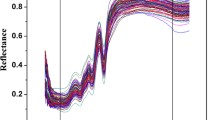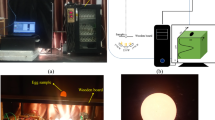Abstract
The objective of this research was to develop an off-line artificial vision system to automatically detect defective eggshells, i.e., dirty or cracked eggshells, by employing multispectral images with the final purpose of adapting the system to an on-line grading machine. In particular, this work was focused on studying the feasibility of identifying organic stains on brown eggshells (dirty eggshell) caused by blood, feathers, feces, etc., from natural stains caused by deposits of pigments on the outer layer of clean eggshells. During the analysis, a total of 384 eggs were evaluated (clean, 148; dirty, 236). Dirty samples were evaluated visually in order to classify them according to the kind of defect (blood, feathers, and white, clear or dark feces), and clean eggshells were classified on the basis of the color of the natural stains (clear or dark). For each sample, digital images were acquired by employing a charged coupled device camera endowed with 15 monochromatic filters (440–940 nm). A Matlab® function was developed in order to automate the process and analyze images with the aim to classify samples as clean or dirty. The program was constituted by three major steps: first, the research of an opportune combination of monochromatic images in order to isolate the eggshell from the background; second, the detection of the dirt stains; third, the classification of the image samples into the dirty or clean group on the basis of the geometric characteristics of the stains (area in pixel). The proposed classification algorithm was able to correctly classify nearly 98% of the samples with a very low processing time (0.05 s). The robustness of the proposed classification was observed applying an external validation to a second set of samples (n = 178), obtaining a similar percentage of correctly classified samples (97%).




Similar content being viewed by others
References
Bamelis, F., Kemps, B., Mertens, K., Tona, K., De Ketelaere, B., Decuypere, E., et al. (2003). Non-destructive measurements on eggs during incubation. Interantional Workshop on Fundamental Physiology and Perinatal Development in Poultry, Adaptation in Poultry (pp. 150–159). Berlin: Science & Technology Letters.
Brant, A. W., Norris, K. H., & Chin, G. (1952). A spectrophotometric method for detecting blood in white-shell eggs. Poultry Science, 32, 357–363.
Coucke, P. (1998). Assessment of some physical egg quality parameters based on vibration analysis. Leuven: Katholieke Univ.
De Ketelaere, B., Coucke, P., & De Baerdemaeker, J. (2000). Eggshell crack detection based on acoustic resonance frequency analysis. Journal of Agricultural Engineering Research, 76(2), 157–163.
Francis, F. J., & Clydesdale, F. M. (1975). Food colorimetry: theory and applications. AVI Publishing Co: Westport.
García-Alegre, M. C., Ribeiro, A., Guinea, D., Cristobal, G. (2000). Eggshell defect detection based on color processing. Machine Vision Applications in Industrial VIII, pp. 280–287. SPIE 2000: San Jose.
García-Alegre, M. C., Enciso, J., Ribeiro, A., Guinea, D. (1997). To an automatic visual inspection of egg-shell defects. In F.Yuste, et al. (Ed.), International Workshop on Robotics & Automated Machinery for Bio-Robotics (pp. 255–260). Gandía (Spain).
Gielen, R. M. A. M., De Jong, L. P., & Kerkvliet, H. M. M. (1979). Electrooptical blood-spot detection in intact eggs. IEEE Transactions on Instrumentation and Measurements, 28, 177–183.
Goodrum, J. W., & Elster, R. T. (1992). Machine vision for crack detect ion in rotating eggs. Transaction of the ASAE, 35(4), 1323–1328.
Kennedy, G. Y., & Vevers, H. G. (1976). A survey of avian eggshell pigments. Comparative Biochemistry and Physiology B, 55, 117–123.
Marcus, R. T., & Kurt, N. (1998). Chapter 2. The measurement of color (pp. 31–96). North-Holland: Azimuth.
Mertens, K., De Ketelaere, B., Kamers, B., Bamelis, F. R., Kemps, B. J., Verhoelst, E. M., et al. (2005). Dirt detection on brown eggs by means of color computer vision. Poultry Science, 84(10), 1653–1659.
Miksik, I., Holan, V., & Deyl, Z. (1996). Avian eggshell pigments and theirnvariability. Comparative Biochemistry and Physiology B, 113, 607–612.
Moayeri, H. (1996). Probe, inrichting en werkwijze voor het testen van eieren. The Netherlands.
Mor-Mur, M., & Yuste, J. (2010). Emerging bacterial pathogens in meat and poultry: an overview. Food and Bioprocess Technology, 3(1), 24–35.
Naebi, A. H., Taghizade, B., Pourreza, H. R., & Fazeli, S. (2008). Automatic detection of eggshell defects based on machine vision. Journal of Animal and Veterinary Advances, 7, 1200–1203.
Otsu, N. (1979). A threshold selection method from gray-level histograms. IEEE Transactions on Systems, Man, and Cybernetics, 9(1), 62–66.
Patel, V. C., McClendon, R. W., & Goodrum, J. W. (1998). Development and evaluation of an expert system for egg sorting. Computers and Electronics in Agriculture, 20(2), 97–116.
Ribeiro, A., García-Alegre, M. C., Guinea, D., & Cristóbal, G. (2000). Automatic rules generation by G.A. for eggshell defect classification. Barcelona: European Congress on Computational Methods in Applied Sciences and Engineering.
United States Department of Agriculture (2000). Egg grading manual, USDA-AMS-Poultry Programs. Washington, DC 20250–0259.
Wesley, I., & Muraoka, W. (2011). Time of entry of Salmonella and Campylobacter into the turkey brooder house. Food and Bioprocess Technology, 4(4), 616–623.
Author information
Authors and Affiliations
Corresponding author
Rights and permissions
About this article
Cite this article
Lunadei, L., Ruiz-Garcia, L., Bodria, L. et al. Automatic Identification of Defects on Eggshell Through a Multispectral Vision System. Food Bioprocess Technol 5, 3042–3050 (2012). https://doi.org/10.1007/s11947-011-0672-x
Received:
Accepted:
Published:
Issue Date:
DOI: https://doi.org/10.1007/s11947-011-0672-x




